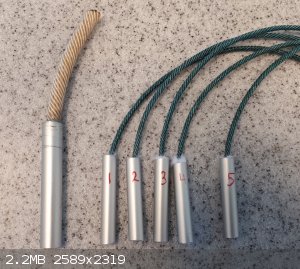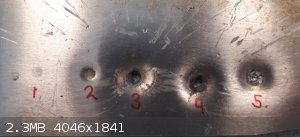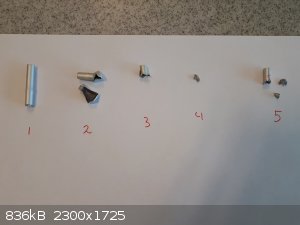| Pages:
1
..
18
19
20
21
22
..
25 |
Laboratory of Liptakov
International Hazard
    
Posts: 1335
Registered: 2-9-2014
Location: Technion Haifa
Member Is Offline
Mood: cool.gif
|
|
We all look forward to the nickel ligand on same base..... ...LL ...LL
Development of primarily - secondary substances CHP (2015) Lithex (2022) Brightelite (2023) Nitrocelite (2024)
|
|
|
Tyneman
Harmless

Posts: 17
Registered: 27-3-2019
Member Is Offline
|
|
As promised, here the results of the Nickel ligand.
It is definetly a bit more (impact) sensitive then it's Cu brother. And I believe a bit more powerful.
http://pyrobin.com/files/Ni-gua-percLQ.mp4
Also the patent states it is neutral.
| Quote: | Furthermore, the explosives of the invention is neutral, d. H. Neither acidic or alkaline. Therefore it is compatible with both acidic and basic
compounds having, in particular secondary explosives, d. H. There will be no decomposition reactions with other explosives during storage. The complex
salt is also highly soluble. This also avoids other explosives unwanted decomposition reaction.
|
Next will be penetration tests. To be continued!
[Edited on 9-5-2019 by Tyneman]
|
|
|
Laboratory of Liptakov
International Hazard
    
Posts: 1335
Registered: 2-9-2014
Location: Technion Haifa
Member Is Offline
Mood: cool.gif
|
|
Hahaaa...!....Incredible beautiful color. And properties also are great from video. Thanks very much.... .....Still some test on pressing into cavity...... .....Still some test on pressing into cavity...... ...... I believe, that nexts examinations bring sure great results. I believe in this sure. For someone can be problem availability of
HClO4. But it seems that exact ratios is not need. Only excess of HClO4. And something will precipitate always.... ...... I believe, that nexts examinations bring sure great results. I believe in this sure. For someone can be problem availability of
HClO4. But it seems that exact ratios is not need. Only excess of HClO4. And something will precipitate always.... ...LL ...LL
Development of primarily - secondary substances CHP (2015) Lithex (2022) Brightelite (2023) Nitrocelite (2024)
|
|
|
Laboratory of Liptakov
International Hazard
    
Posts: 1335
Registered: 2-9-2014
Location: Technion Haifa
Member Is Offline
Mood: cool.gif
|
|
strategic mixtures
Safe mixtures for detonators have existed long ago. They have long been developed and tested. There may be dozens of relatively safe compounds for
detonators. But they are not meant for amateurs. They are locked in the vaults of national laboratories. Like many other strategic information.
Similar to CHP, which bridges the gap between primary and secondary materials. To date, there is no single official study for TACP and its features.
Where it would be officially written: Yes, TACP + fuel can provide a detonation pressure of up to 25 GPa. And has an easy D-D Transition. Therefore,
the S -M community must (or can) discover and test many materials in amateur conditions. Again. Without the support of national laboratories. No
support because it is a strategic information and material.
Development of primarily - secondary substances CHP (2015) Lithex (2022) Brightelite (2023) Nitrocelite (2024)
|
|
|
Tyneman
Harmless

Posts: 17
Registered: 27-3-2019
Member Is Offline
|
|
guanidine ligands
Finally got around to some testing.
I made 5 small detonators, an average CHP det to the side for comparison. (pic1)
Dimensions were 4mm x 6mm Al tubes 35mm long.
Contents:
1: 0,1g PETN @ 30Kg - 0,05g PETN @ 15Kg - 0,02g NiQP @ 5Kg
2: 0,1g PETN @ 30Kg - 0,05g PETN/CHP 50/50 @ 15Kg - 0,02 NiQP @ 5Kg
3: 0,1g PETN @ 30Kg - 0,05g PETN @ 15Kg - 0,02g CuQP @ 5Kg
4: 0,1g PETN @ 30Kg - 0,05g PETN @ 15Kg - 0,05g NiQP @ 5Kg
5: 0,15g PETN @ 15Kg - 0,02g NiQP @ 5Kg
All detonators placed perpendicular on a 4mm Al plate.
Results:
Topside, see picture 2
Backside, see picture 3
Measurements:
1: Indent 0,1mm.
2: Indent 1,5 mm.
3: Full penetration, diameter hole 4mm.
4: Full penetration, diameter hole 3mm.
5: 90% penetration, 3,5mm bulge on backside.
Debris recovered after detonation, see picture 4.
Comments and discussion are welcome
   
|
|
|
Laboratory of Liptakov
International Hazard
    
Posts: 1335
Registered: 2-9-2014
Location: Technion Haifa
Member Is Offline
Mood: cool.gif
|
|
3. Looks good. So was use aminoguanidine copper perchlorate? Or only guanidine copper perchlorate? I am confused from all the ligands....
Any way, great a piece of work. Finaly someone, who tested something really... ....LL ....LL
Development of primarily - secondary substances CHP (2015) Lithex (2022) Brightelite (2023) Nitrocelite (2024)
|
|
|
Tyneman
Harmless

Posts: 17
Registered: 27-3-2019
Member Is Offline
|
|
Full name should be Ni (II) di(monoaminoguanidin) diperchlorate. But hey, what's in a name? I thought Q was the abbreviation for aminoguanidin, is it
just guanidine?
Is there a common abbreviation for this 'thing' ?
|
|
|
Microtek
National Hazard
   
Posts: 827
Registered: 23-9-2002
Member Is Offline
Mood: No Mood
|
|
Well, nitroguanidine is NQ, so logically aminoguanidine should be AQ. However, I think I have seen Ni (II) di(monoaminoguanidin) diperchlorate
abbreviated as ANP...
|
|
|
MineMan
National Hazard
   
Posts: 998
Registered: 29-3-2015
Member Is Offline
Mood: No Mood
|
|
So the copper ligand is better? Anyone have any other metal ligand that might work even better, like silver? What is the synth for the copper ligand
and how does the sensitivity compare to the Ni? I am beyond greatly interested in your answers.
Thank you
Mineman.
|
|
|
Tyneman
Harmless

Posts: 17
Registered: 27-3-2019
Member Is Offline
|
|
Synth for the copper ligand is posted on previous page. Aswell as some friction and impact tests.
I will make a little comparison side by side this week.
Cobalt is allso an option, but patent states it gives some thick liquid as result from which it is hard to separate crystals. But might give that one
a try to. Silver is also stated to work, but I can't find any info on that one, only one way to find out I guess...
|
|
|
twelti
Hazard to Others
  
Posts: 217
Registered: 20-2-2019
Member Is Offline
|
|
Quote: Originally posted by snooby  | | Another one: double salt of am guanidine bicarbonate and nickelperchlorate. Very easy to make, just boil components and filter of crystals.
Sensitivity tests has yet to come though! Sorry for doublr post. In confinement this stuff detonates. |
I made a little of the nickel complex, it detonates even wo confinement (and how!). Copper complex seems to need it. Are you washing it with
anything? I just poured mine on to a paper towel, since there is so little liquid.
|
|
|
Tyneman
Harmless

Posts: 17
Registered: 27-3-2019
Member Is Offline
|
|
| Quote: | | Are you washing it with anything? |
I washed twice with cold dH2O and once with cold EtOH.
| Quote: | | So the copper ligand is better? |
At first glance I thought it was actually less powerful then the Ni counterpart. It is less friction and impact sensitive for sure IMO. Deto tests
showed the Cu to be more powerful. Wich was not what I expected. If it is indeed more powerful and less sensitive that would make it better yes.
Please compare the tests in my two vids I posted.
I will be doing more testing soon, aswell as try to make Ag and Co ligands.
|
|
|
Laboratory of Liptakov
International Hazard
    
Posts: 1335
Registered: 2-9-2014
Location: Technion Haifa
Member Is Offline
Mood: cool.gif
|
|
Very interesting results from Tyneman testing. It confirmed old rule, that behaviour on air is (almost always) some else than in solid cavity. Basic
energetic properties is necessary measured in conditions, which will use. As final applications. And not repeatedly between two stones as troglodyte.
Or dancing around it and throw into flame. A like an shaman. You won't find out anything.... ....LL ....LL
(OK, copper ligand is best)
Development of primarily - secondary substances CHP (2015) Lithex (2022) Brightelite (2023) Nitrocelite (2024)
|
|
|
Microtek
National Hazard
   
Posts: 827
Registered: 23-9-2002
Member Is Offline
Mood: No Mood
|
|
You need more than one repetition of a test to find out which one is best.
|
|
|
Tyneman
Harmless

Posts: 17
Registered: 27-3-2019
Member Is Offline
|
|
You are very right there Microtek!
That is why | Quote: | | I will be doing more testing soon, |
These are just first results, but they seem viable enough to try and get others to test them too. Even if I test more, other peoples results may
differ and shed a new light.
So I hope to get others to synthesise and test them. Which can only be done by showing what I have done sofar.
|
|
|
twelti
Hazard to Others
  
Posts: 217
Registered: 20-2-2019
Member Is Offline
|
|
I have been making some small batches - both Ni and Cu. It seems that in the patent it says to boil for 5 minutes and then cool to RT for four hours.
I tried that and got needles. Is some other batches where I went straight to ice bath, I got smaller crystals. I guess that is not surprising. I
wonder what else I could do to reduce crystal size.
I'm also not sure how much water I should be adding and when to add. Should I add more as the reaction continues, and how much will I lose in a water
wash during filtration?
Is there any way of desensitizing it? It seems very powerful, but not as insensitive as I'd hoped, at least so far.
|
|
|
Microtek
National Hazard
   
Posts: 827
Registered: 23-9-2002
Member Is Offline
Mood: No Mood
|
|
When you have boiled the mix, and it is time to let it cool down and precipitate the product, just keep on stirring it (preferably not by hand). This
will prevent the formation of large crystals, but will still give a product that is easy to filter and handle.
You should not add any more water during the course of the reaction, just what is needed in making the solutions in the first place.
|
|
|
Tyneman
Harmless

Posts: 17
Registered: 27-3-2019
Member Is Offline
|
|
To get smaller crystals you could try to let it cool whilst stirring. Agitation should reduce Cristal size.
I only used water at the beginning, slurry the aminoguanidine, and dissolve the NiPerc in a little (10mL) dH2O. No further additions.
|
|
|
Rosco Bodine
Banned
Posts: 6370
Registered: 29-9-2004
Member Is Offline
Mood: analytical
|
|
A suggestion I have about the copper and nickel compounds is to experiment with a synthesis that produces *both* at the same time from their mixture
of precursors, to see if a complex compound salt or double salt may form having different crystalline and physical form that may be an improvement.
|
|
|
Microtek
National Hazard
   
Posts: 827
Registered: 23-9-2002
Member Is Offline
Mood: No Mood
|
|
Yes, I have used that strategy before with some of the "green primaries" based on nitrotetrazole transition metal complexes. I doped the nickel salts
with a little silver in order to co-precipitate a small amount of silver nitrotetrazolate. This increased the DDT ability and lessened the requirement
for confinement without too much increase in sensitivity.
|
|
|
wessonsmith
Hazard to Others
  
Posts: 203
Registered: 15-2-2018
Location: elsewhere
Member Is Offline
|
|
Very safe and powerful detonator composition.
below
[Edited on 23-5-2019 by wessonsmith]
|
|
|
MineMan
National Hazard
   
Posts: 998
Registered: 29-3-2015
Member Is Offline
Mood: No Mood
|
|
Wessonsmith. Confused we are by your post.
|
|
|
twelti
Hazard to Others
  
Posts: 217
Registered: 20-2-2019
Member Is Offline
|
|
I think he put his comment inside the html quote.
Can you not press any primary wet, then allow to dry?
|
|
|
wessonsmith
Hazard to Others
  
Posts: 203
Registered: 15-2-2018
Location: elsewhere
Member Is Offline
|
|
My detonator mix has two parts. 1) A composition consisting of 500mg 65% Nickel Hydrazine Nitrate (NHN) / 35% Sodium Nitrotetrazole Dihydrate (NaNTz)
which is intimately mixed together then pressed into detonator tube (I press the comp to 1.7 g/cm³ using an Irwin vise) and heat-treated at 107°C
(225°F) for 4hrs. The heat treatment drives off the water of crystallization of the NaNTz Dihydrate leaving behind NHN tightly packed with the
anhydrous version of NaNTz.
Since the Dihydrate version of the composition is VERY insensitive, there is no fear of loading it. 2) 50mg NHN added on top of the heat treated mix
to help the Visco fuse in setting it off.
What you have is a detonator composition that is “green”, set off with Visco fuse, very powerful, safe to load, not reactive to metals or plastics
and can sit on a shelf for a decade or more.
[Edited on 23-5-2019 by wessonsmith]
[Edited on 23-5-2019 by wessonsmith]
|
|
|
wessonsmith
Hazard to Others
  
Posts: 203
Registered: 15-2-2018
Location: elsewhere
Member Is Offline
|
|
Quote: Originally posted by twelti  | I think he put his comment inside the html quote.
Can you not press any primary wet, then allow to dry? |
My primaries are not wet. NaNTz Dihydrate has the water of crystallization that is being removed to make the anhydrous form of NaNTz. Not sure how
pressing actually wet primaries would work. Probably make quite a mess.
|
|
|
| Pages:
1
..
18
19
20
21
22
..
25 |